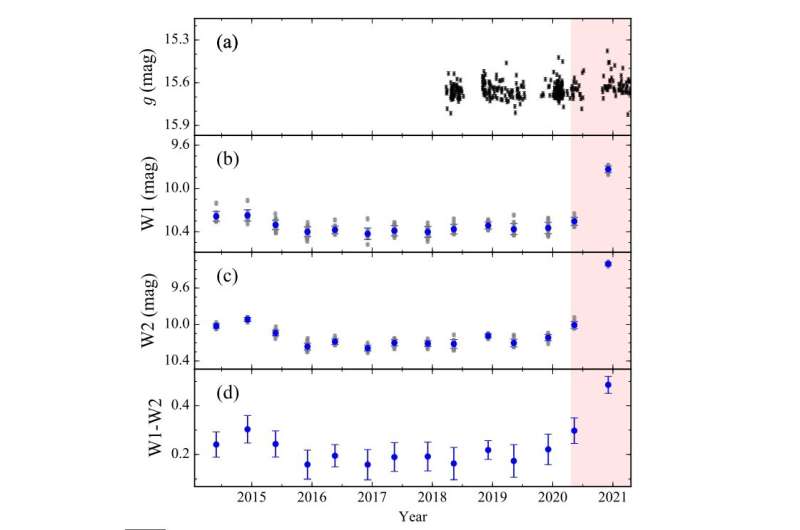August 30, 2022 report
Mid-infrared flare observed in the galaxy NGC 3786

Using NASA's Wide-field Infrared Survey Explorer (WISE), astronomers from South Korea and China have detected a mid-infrared flare in an active spiral galaxy known as NGC 3786. The researchers assume that this peculiar flare may have originated from a tidal disruption event (TDE). The discovery was detailed in a paper published August 17 on the arXiv pre-print server.
At a redshift of approximately 0.009, NGC 3786 (other designations PGC 36158 and UGC 6621) is a type 1.8 Seyfert spiral galaxy in the constellation Ursa Major. It has an apparent size of 2.1 by 1.1 arcminutes and together with NGC 3788 forms an interacting pair of galaxies dubbed Arp 294.
A group of astronomers led by Suyeon Son of the Kyungpook National University in Daegu, South Korea, reports a peculiar infrared-only flaring event that occurred in NGC 3786. The finding is based on the multi-epoch photometric data from WISE.
"By comparing this dataset with light curves in the optical band, we serendipitously discovered an infrared-only flare in NGC 3786, which appeared to have occurred around mid-2020," the researchers wrote in the paper.
The amplitude of this bright mid-infrared flare was about 0.5 and 0.8 mag in WISE W1 and W2 bands, respectively. These values are 6−8 times larger than before the flare. However, no significant increase in brightness was observed in the optical monitoring data from 2019–2021 obtained with the Zwicky Transient Facility (ZTF).
Trying to shed more light on the nature of this flare, Son's team obtained optical and near-infrared (NIR) spectroscopic data using Gemini Observatory's GMOS and GNIRS spectrographs. They found that broad emission lines in Paschen-alpha (Paα) and Paschen-beta (Paβ) newly appear, while the broad hydrogen (Hβ) emission is marginally detected in the post-flare spectrum.
Moreover, the newly appearing broad emission lines turned out to be redshifted up to 900 km/s. It was noted that such a high-velocity offset is often observed in changing-look (CL) active galactic nuclei (AGN), possibly resulting from the eccentric tidal debris generated from the so-called tidal disruption event (TDE) phenomenon.
Studies show that TDEs can exhibit infrared emission radiated from the circumnuclear dust heated by the X-ray/ultraviolet continuum from the accretion disk. The researchers explained that TDEs are occasionally reported to be accompanied by a CL behavior in AGNs, wherein the appearance or disappearance of broad emission lines and thermal continuum from the accretion disk occurs.
According to the authors of the paper, the results suggest that in the case of NGC 3786 the observed mid-infrared flare is highly obscured by circumnuclear dust and associated with the CL AGN phenomenon. They concluded that this flare may have originated from a TDE as it is the most plausible scenario to explain the velocity shifts in the broad emission lines.
More information: Suyeon Son, Minjin Kim, Luis C. Ho, Dohyeong Kim, Taehyun Kim, A Mid-infrared Flare in the Seyfert Galaxy NGC 3786: A Changing-look Event Triggered by an Obscured Tidal Disruption Event? arXiv:2208.08062v1 [astro-ph.GA], arxiv.org/abs/2208.08062
© 2022 Science X Network





















